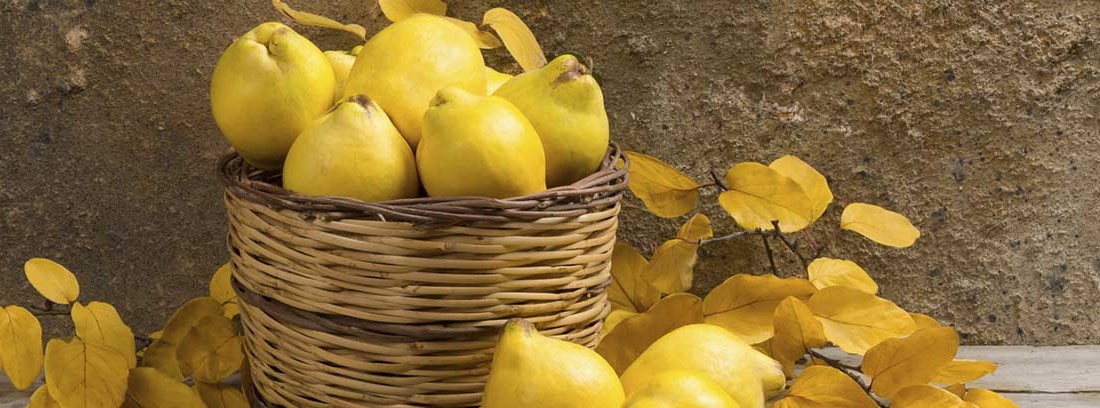What are the health benefits of quince?

Nutritional composition
The quince, despite being a fruit, stands out for its low sugar content and for his low caloric intake. But its sour taste and hard texture mean that it is mostly eaten in quince jelly shape, to which add sugars in its preparation and as a consequence the content of these increases considerably, as well as the caloric intake. Its nutritional content is not very prominent in terms of vitamins and minerals, except for potassium. Are the fibers and tannins those that give the healthy properties to the quince.
Featured Nutrients
Potassium Fiber: pectins and mucilages
The quince provides a large amount of, like pectins and mucilages. The pectins and mucilages they are a type of Soluble fiber (It is the one that when it comes into contact with water forms a voluminous gel-like substance that delays gastric emptying helping digestion, and is capable of capturing substances at the intestinal level, in addition to softening and helping to eliminate stool).
Potassium
This mineral typical of vegetables is dispensable for the transmission and generation of the nerve impulse, participates in muscle contraction, as well as in the water balance both inside and outside the cell. One of the consequences of loss of electrolytes due to dehydration, it may be suffer cramps, so a diet rich in vegetables and fruits, legumes and nuts will help to obtain enough potassium to prevent cramps.
Health benefits
The healthy properties of the quince are provided by the fibers, both the mucilages, the pectins and the tannins.
Astringent action
The pectin of ripe quince and sweet quince gives it astringent properties. This fiber, in contact with water, creates a gel that retains water, so the liquid stools typical of diarrheal processes improve, becoming more dense, thus improving diarrhea. What's more, tannins of the quince also have properties astringent and anti-inflammatory, and help reduce inflammation of the mucosa of the intestine, enhancing the treatment against diarrhea.
Digestive problems
Pectins reduce gastric acidity, so its consumption is recommended in digestive disorders such as gastritis, gastroduodenal ulcer, etc. and tannins help improve inflammation.
May improve cholesterol levels
Once again, the action of the quince fiber, by forming a viscous gel when it comes into contact with water, captures substances at the intestinal level, such as l, which reduces its absorption, thus improving blood values.
It is diuretic
Its high potassium content and low sodium content can make decrease the values of arterial hypertension or blood vessel conditions, as long as they are not associated with excess weight.
When to take or not
- Quince sweet can be ideal for athletes of all ages, people who need to gain weight or those who have a lack of appetite. Provides an extra intake of calories in the form of simple sugars.
- Because it is consumed mainly in the form of candy,not recommended in diabetic people, who suffer from hypertriglyceridemia and / or excess weight, as it provides 230 kcal per 100 grams of quince jelly. It is also not recommended for people with kidney failure or who require potassium-controlled diets.
How to choose and keep it
The quince is a seasonal fruit, it is harvested at the end of September or the beginning of October and lasts until the end of January. Once collected it can last between two and three months. We must choose those of yellow color, smooth and without bumps. If its skin is green, the quince is immature, but if, on the contrary, it is yellow with black spots, it is too mature. We can keep it in the fridge for several weeks, wrapped in paper and separately.
- Due to its sour and astringent taste, quince is rarely eaten raw. It is usually taken in the form of quince paste, to which sugar is added in its preparation (80% of the weight of the quince meat).
- The healthy properties of the quince are provided by the fibers, both the mucilages, the pectins and the tannins. The most remarkable property is that it improves diarrheal processes.
- The yellow color of the quince indicates that it is ripe, and if the skin of the quince is green, the quince is immature. On the contrary, when it is yellow with black spots, it means that it is excessively ripe.
Diploma in Human Nutrition and Dietetics Master in Pediatric Nutrition and Sports Nutrition
(Updated at Apr 14 / 2024)